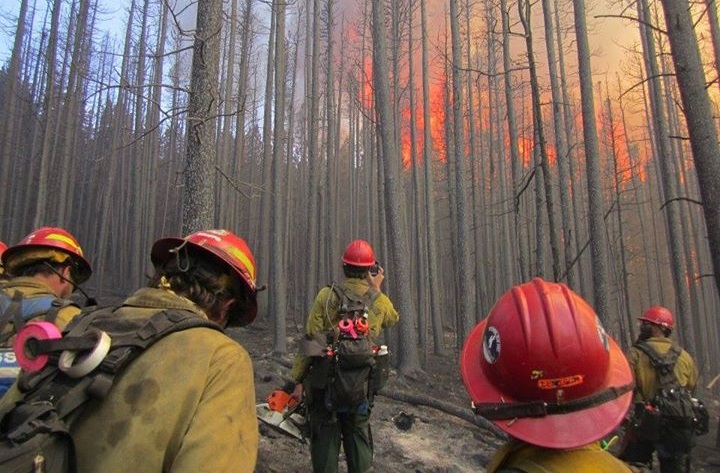
A fire at Russel's Camp, Wyoming in 2012.
Wildland fires ravage the Western United States like dogs at a BBQ, tearing through 9,362,238 acres of land in 2013 alone. But where would the numbers clock in at if we had no fire fighters?
If we just let the trees go up in smoke—literally—and stand watching as hundreds of years of growth comes down with a thud, what would our country look like? How many more trees in the Redwood National Forest would be charred, how many forests in Montana would be dried and barren?
The people who fight fire are often underrated, and once the fire is gone, the attention goes with it. The people who spend weeks at a fire, working 12-, 26-, even 30-hour shifts to ensure our forests stay safe deserve recognition. There’s more than 33 million acres of forest in California alone—a state that is almost always on high fire alert—and without the long hours and hard work the U.S. Forest Service fire workers put in, we might be missing a few acres, or millions.
The crews that choose to spend their summers suited up in full gear, hiking toward remote locations, and then attempting to challenge one of nature’s most powerful elements risk their lives for the sake of our forests, and for that we should be grateful. They respond to more than 10,000 forest fires each year.
To onlookers, the job seems treacherous at every turn, but those who do the work seem fairly calm. It’s hard work, but not always as dangerous as depicted.
Every scenario is not all walls of flame, as many aspects of the job are romanticized. When the average American pictures a forest fire, clouds of flames tumbling down mountainsides claiming everything in a 10-mile radius may come to mind.
This happens, rarely, but often forest fire fighters are controlling slower fires that are manageable. The people who work in fire aren’t always the human rendering of Smokey Bear, either. They aren’t radical environmentalists spouting riot calls like water from a fire hose—they’re normal people who like the work because of its challenging nature.
In fact, forest fire fighters often don’t even use fire hoses.
“We dig lines with hand tools and we use chainsaws to cut out the canopy, we don’t use any water unless you’re drinking it,” said Dylan Hillyer, a member of the Tatanka Hotshot crew out of the Black Hills National Forest in Custer, South Dakota.
A hotshot crew is a hand crew that is generally put on tougher assignments, usually made up of about 20 people. Digging line is a fairly common technique, and it involves digging in front of where the fire is creeping toward and creating a barrier, usually about two feet across composed of all mineral soil. Any roots in the soil would catch fire, so the line has to be stripped of any fuel, or things that can burn, so as to stop the fire at the line.
It’s a slow and drawn out process, very different than the action-packed adventure that is often shown in films.
There’s no doubt that it’s tough, though. The hard work that is portrayed along with the action is nothing short of accurate.
For Hillyer, it’s the challenge that keeps him coming back to the job. For half of the year, he attends the University of Northern Iowa, but come summer, he abandons the Midwestern state for the West. Working with the Tatanka Hotshots has taken him to South Dakota, Wyoming, Montana, Colorado, New Mexico, and Arizona.
“It’s a great place to grow no matter what you’re going to work with people in all different leaderships, and you’re going to learn from that,” Hillyer said.
For Engine Captain Shane Phillips at the Black Hills National Forest, he fell into the job by chance. He had been working for the U.S. Forest Service during his summers also, and grew up near a national forest. Initially, he was drawn to the job because of the environment, but has stayed because he is always doing something new.
He agreed that a lot of what is portrayed of firefighters isn’t necessarily true.
“I think one of the biggest misconceptions that people have with the job we do is that the media shows big flames and air tankers and people running from houses, and most of that is truly 10-20 percent of the real job that most of the firefighters do,” he said.
Most of the work is being done during the mop up stage, which is using mineral soil and water to fully extinguish a fire.
“It takes a special person to be diligent and work multiple days doing the mundane tasks, but they’re just as important as the big fire flames in the area,” Phillips said.
They’re humble, they understand the work they do is important, but the act of doing it is also enjoyable for them. There is no bargaining for a piece of the land, it isn’t an environmental duty—it’s something they enjoy doing, and something they’re good at.
It isn’t an easy job, and it’s surely not a clean one either. Hillyer said he wasn’t expecting to get as dirty as he did.
“You’re a grungy smelly human being after working hard, and I’ve had the privilege of being on crews that work really hard,” he said.
For crews that are constantly on the move, the job changes with the terrain, and even in the same location, each fire is unique. There is definitely more than what’s included in the job description.
Even if forest fire fighters aren’t in it for the environmental impact, they’re making a difference. Even if their motives are their own, they’re doing something the rest of us are thankful for, whether it fits the job description or not.
Photos courtesy of Dylan Hillyer
 Your Privacy Choices
Your Privacy Choices

